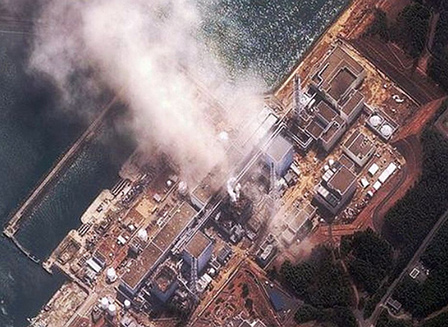The following article originally appeared on The
Archdruid Report.
Observers
of the mechanics of decline and fall found plenty to keep them occupied over
the last week. As I write these words, bombs are falling in Libya as the
Western powers hurriedly resort to military force; Libyan strongman Moammar
Gaddafi's moves toward selling his oil and natural gas to China and India
rather than the European nations that have received most of it to date probably
explains this abrupt and almost panicked change in tactics.
Meanwhile, the immediate human impact of Japan's devastating March 11
earthquake and tsunami seems to be ebbing. The Japanese military and rescue
teams from a hundred other countries have succeeded in bulldozing open
transport routes into the stricken Tohoku region, and food and emergency
supplies are beginning to reach the survivors. Still, at least two other
dimensions of the crisis are still ongoing, and show every sign of getting
worse before they get better.
The first of these is the economic impact of a disaster that leveled one of
Japan's major industrial regions. In a global economy geared to extreme
specialization and just-in-time delivery, the sudden destruction of scores of
factories, chemical plants, warehouses, and shipping facilities is a body blow
with potentially wide-ranging effects. One GM plant in the United States has
already been forced to shut down because a Japanese factory that was once a
crucial part of its supply chain suddenly turned into a heap of salt-stained
debris. Over the months ahead, as products already shipped reach their destinations
and the details of the disaster become clearer, we will get to see just how
thoroughly the proponents of global economic integration got their wish. The
possibility that more factories shut down, more jobs are lost, and some
consumer goods are in very short supply for months thereafter can't be
dismissed out of hand.
The second ongoing aspect of the crisis, of course, is the Fukushima nuclear
disaster. More than a week on, the situation at the crippled plant remains
dangerously unstable. Emergency crews on the scene are putting their lives on
the line to keep three partially melted reactor cores and two critically
damaged fuel rod storage tanks from overheating; so far, they've succeeded well
enough that leaks of radiation and high-level nuclear waste have been sporadic,
but the struggle's not over yet. Even in the best case scenario, the utility
that owns the plant has just had a very expensive and profitable facility turn
into a heap of smoldering radioactive junk, and the ensuing financial meltdown
may do as much damage to the nuclear power industry as an actual core meltdown
at the plant.
Proponents of nuclear power
have tried to put their spin onto a situation that seems to be taking a
perverse pleasure in frustrating them. One of their tactics seems to have
shifted into overdrive over the last week: the insistence that even though all
past and nuclear technologies have turned out to be far less safe and
spectacularly more expensive than their promoters claimed at the time, future
nuclear technologies not yet off the drawing boards will surely be safe, clean,
cheap, and reliable sources of energy. Those of my readers who know their way
around the software industry have heard this kind of song and dance before,
often enough so that there's a useful term for it among computer geeks:
vaporware.
The mass production of vaporware in the energy field is hardly limited to the
nuclear industry's shills and unpaid fans, to be sure. Connoisseurs of the
absurd will remember the flurry of optimistic claims about algal biodiesel
released a couple of years ago by GreenTech, which got plenty of money from
venture capitalists until an outside analysis showed that their process
wouldn't make a profit until the price of diesel fuel broke $800 a barrel.
Still, for some reason nuclear power seems to attract an uncommon number of
vaporware schemes. Whether it's liquid sodium or lead-bismuth reactors, fourth
generation this or modular that — and let's not forget the fusion advocates,
still chasing a phantom that has hovered twenty years in the future since
before I was born — bring up energy issues online and you're sure to get
somebody making grand claims about some kind of nuclear vaporware.
There are at least three good reasons to ignore them. The first is that every
generation of nuclear technology has been sold with exactly the same sales
pitch — those of my readers who recall the Eisenhower administration will
remember how, back then, publicists for the industry insisted that clean, safe
nuclear power would soon make electricity too cheap to meter — and it's turned
out to be wrong every single time. There's no reason whatsoever to think that
the current crop of publicity releases will be any more accurate. It's easy to
make a technology look good if it doesn't exist yet, and the inevitable
technical problems have not been faced, but after this many rounds of grand and
unfulfilled promises, it's arguably time to roll our eyes and walk away.
The second is that building more nuclear power plants, of any kind, is far from
the most cost-effective way to deal with shortfalls in energy here in the
United States. Nuclear advocates have made much of claims that the only
alternative to more nukes is burning coal, but there's a much simpler, saner,
and cheaper alternative: conservation. The sort of cheap and simple
conservation retrofits we've been discussing in this blog for the last few
months can cut home energy consumption by 20% or more. Such measures were at
the heart of the industrial world's successful response to the energy crisis of
the 1970s, and the fact that they're ignored by all nearly all sides in today's
energy debates — including too many supposed environmentalists — does not speak
highly of the collective intelligence of our time.
It's worth noting, for example, that for the amount of money it would take to
replace the 23 US nuclear reactors that have the same flawed design as the ones
at the Fukushima Daiichi plant — $276 billion, at an estimated average total
cost of $12 billion per reactor — we could give every one of the 130 million
homes, apartments, and condominiums in the United States a $2000 conservation
retrofit, including caulking, weatherstripping, insulation, and the like, with
room in the budget to spare. That would save more power than those nukes would
generate, and do it with no fuel costs, no security threats, no radioactive
waste, no risk of catastrophic meltdowns, and an annual maintenance budget per
home equal to a couple of takeout pizzas.
A comparable option, a little more costly per housing unit but with similar
paybacks, would involve getting solar water heaters on the roofs of America's
houses, apartments and condominiums, and commercial and industrial facilities. It's
arguably the most thoroughly developed renewable technology we've got; a
century ago, solar water heaters were standard in American housing across the
Sun Belt, and only the brief heyday of cheap fossil fuel energy squeezed them
out of the market. It's high time we put them back to work.
There are three basic types of solar water heater: batch, passive thermosiphon,
and closed-loop active. Batch heaters are the simplest and most robust of all;
they can be made and installed by an ordinarily competent handyperson for less
than $1000 a piece. They consist of a tank, painted black, in a box with glass
walls facing the sun and insulation everywhere else. The simple version is
operated by hand: in the morning, as long as the weather is above freezing, you
fill the tank by turning a tap; later in the day — the interval varies
depending on location, size of tank, and intensity of sunlight — you have a
tank of hot water that you can use in all the usual ways.
You can also feed a batch heater into your regular hot water system, but there
are more effective ways to use solar energy if this is your plan. The reason I
mention batch heaters here at all is that, as the simplest and cheapest solar
water heating system, they're probably the one that will be standard a century
or two from now, when the end of the age of fossil fuels has broken our
descendants of the bad habit of thinking that they have a right to expect
energy when, where, and how they want it. Afternoon laundry and evening baths
may well be standard in that age, though it's by no means impossible that
they'll also pick up the trick of running water through pipes in the back of a
woodstove when it's fired up, and use the two systems jointly to keep hot water
ready on tap. (We'll be discussing that, and the possibilities and problems
with wood stoves, in a later post.)
Still, for the time being, those of my readers who like hot water throughout
the day have other options. If you live in a part of the world that doesn't get
freezing temperatures in the winter, a passive thermosiphoning system is
usually your best bet. This has a set of panels through which water flows, and
a well-insulated tank located above the panels, so that hot water rises from
the panels into the tank, and cooling water cycles from the tank back down to
the panels. The tank connects to your regular water heater, which thus has a
lot less heating to do — when the sun is out, in a well-designed system, none
at all.
In areas that freeze in the winter, the standard approach is an closed loop
active system that uses something other than plain water to take heat from the
panels and circulate it into the tank. Various antifreeze solutions are
standard; they go from the panel to a heat exchanger in a well-insulated tank,
and a small electric pump (which can be powered by a photovoltaic panel) keeps
the fluid moving. Once again, heat goes from the panels to the insulated tank,
hot water from the insulated tank goes into the regular water heater, and keeps
it from having to work hard or, under good conditions, at all.
On average, a thermosiphon or closed loop system will provide you with 70% of
your hot water free of charge, though that figure varies significantly by
location; in Sun Belt locations with plenty of clear skies, it tends close to
100%. Since water heating accounts for around 15% of the average household
energy bill, a solar water heater in an average location will account for
around 10% of your home energy. The cost for systems of this kind varies widely
depending on the details of the system, the orientation of your house toward
the sun, and the ease with which pipes can get from the solar system to your
ordinary hot water system, but $4000 is a good ballpark for a passive
thermosiphon system and $8000 for a closed loop active system. It's a
noticeable upfront cost, to be sure, but here again it's worth remembering that
there are no additional fuel costs for as long as the sun is well stocked with
hydrogen.
There are probably other ways to heat water using the sun that haven't been
invented yet, but the three I've just mentioned have a major advantage: they
represent mature technologies, with strengths and drawbacks that have been
tested thoroughly in practice. To put it another way, they're the opposite of
vaporware; when you install a solar water heating system, you know exactly what
you're getting into, and though it can sometimes be necessary to correct for
the pitches of overenthusiastic salespeople, most of the firms that install
solar hot water systems these days have been around for decades and have
learned, as most small businesses learn, that satisfied customers are the
advertising that matters. You can also look up the performance of the available
models in a variety of independent sources, go fishing for complaints on the
internet, and do everything else you would normally do when assessing a piece
of technology for your home.
You can't do that with vaporware. If someone came knocking on your door and
offered you a chance to buy an exciting new water heater using advanced
technology, you'd probably want to know how well it worked in practice, and if
the salesman wanted a dizzyingly high price up front for a heater that had
never been built or tested, was ultimately nothing more than an appealing
concept, and wouldn't be ready for decades, I doubt, dear reader, that you'd go
running for your checkbook. This is what the proponents of untested new nuclear
technologies are doing, and once again, it's worth recalling that the sales
pitches they're repeating right now are the same ones that were used to justify
building the reactors at Fukushima.
That points up the third and, to my mind, conclusive reason to ignore the
promoters of nuclear vaporware: we don't have the time to spare. Peak oil is
already here, peak coal and natural gas are a good deal closer than the
cornucopian assumptions of previous decades liked to admit, and peak
fissionable uranium — the fuel for our existing reactors — is not far off
either. We can't afford to take the risks involved in pouring hundreds of
billions of dollars into untried nuclear concepts that may prove to be as
unworkable as fusion or as fatally flawed as the Fukushima reactors, and in the
very best case won't produce a watt of power for decades to come. A realistic
approach to the looming energy crisis of our time, rather, will have to depend
on existing technology, and especially on mature and thoroughly tested
technologies that have proven themselves to be safe, effective, compatible with
existing systems, and capable of meeting genuine human needs. Those
technologies exist; they won't enable us to continue to waste energy with the
unthinking carelessness that most Americans have somehow come to think of as
one of their inalienable rights; but they do offer a realistic way of providing
a viable, comfortable, and humane existence as we extract ourselves from the
tight corner into which the vaporware salesmen of the past have wedged us.
Resources
Once again, the starting point for green wizards interested in solar water
heating is the Master Conserver papers available online at the
Cultural Conservers Foundation website; the papers you want are
those on passive solar water heating and active solar water heating. There have
been some useful improvements introduced since these were published, but they
still provide an excellent introduction to the basics of the technology.
Readers interested in building batch systems should find a copy of Daniel K.
Reif's classic Passive Solar Water
Heaters; which provides plenty of information and detailed plans for two
systems. David A. Bainbridge's The
Integral Passive Solar Water Heater Book is a good sourcebook for the range
of batch designs in use or under development in the late 1970s and early 1980s.
Passive thermosiphon and closed loop active systems are beyond the reach of all
but a very few home workshops; if you want to go this route and have the funds,
your best bet is to talk to a professional. There are solar energy companies in
every region of the United States and a good many countries abroad that can set
you up with a system suited to your location.
Image by daveeza, courtesy of Creative Commons license.













